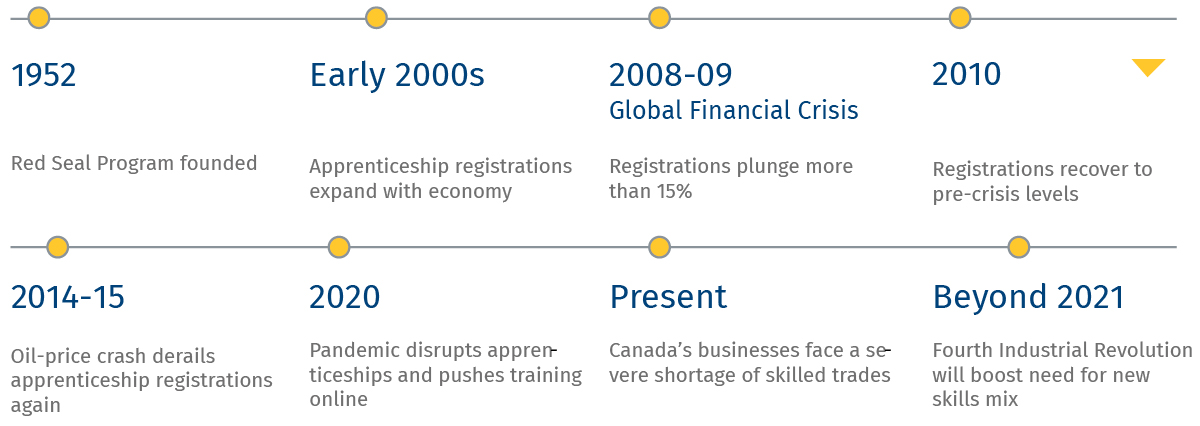Key Points
- 25% of Canada’s 4 million tradespeople will need to upgrade their skills within five years amid significant digital disruption.1
- Canada will face a shortage of at least 10,000 workers in nationally recognized Red Seal trades over that period—a deficit that swells tenfold when 250 provincially regulated trades are included.2
- The most severe shortages will be among trades critical to the coming infrastructure boom, including industrial mechanics, welders and boilermakers.
- Demand for digital and “soft” skills like creativity and problem solving is expected to rise significantly in these critical trades.
- Over 700,000 skilled tradespeople are expected to retire by 2028. Meanwhile, an outdated perception of the trades has hobbled recruitment efforts.
- Women made up just 11% of new registrants for apprenticeship programs in 2019 and continue to represent less than 4% of workers in the most in-demand trades.3
- Immigrants comprised 8.7% of apprentices despite accounting for more than 20% of the population.4
- Canada is falling short of its goal to bring in 3,000 skilled tradespeople annually through immigration, admitting 2,365 such newcomers in 2019 through the Federal Skilled Trades Program.5
- Educators, employers and policymakers will need to address chronic problems in the trades pipeline, tap into underused pools of talent, and address a widening digital skills gap amid rapid technological advances in the workplace.
Wanted: a bigger toolbox
Virtual-reality headsets show blueprints to workers as they walk through a construction site. A carpenter plots precise cuts down to the millimeter with the aid of computer-assisted design. A welder performs her job remotely with the help of a robot.
Technological change, accelerated by the pandemic, has transformed not only the tools available to tradespeople, but the skills needed to operate them. Today’s industrial mechanics, electricians and automotive service technicians must have the digital savvy to operate the electronic-testing equipment, 3D technology, and digital diagnostic tools becoming commonplace in the manufacturing and construction sectors. They will also have to brace for frequent retraining on evolving technologies.
Meanwhile, soft skills—critical thinking, curiosity, creativity, problem solving and communication—are more important than ever in an economy that demands collaboration across sectors. These skills will increase in importance as the Fourth Industrial Revolution unfolds. But they won’t replace traditional technical ability. A foundational understanding of metallurgy, for instance, will remain crucial to a welder programming a robotic arm.
Canada’s skilled tradespeople—the welders, machinists, electricians and plumbers that have long been the backbone of our economy—are more critical than ever. In this report, we identify the main challenges facing the sector—the underrepresentation of women and immigrants, the need to double down on digital training, and the ongoing stigmas surrounding trades careers—and how best to tackle them. The challenges are significant. So are the opportunities.
This RBC report was developed within our Humans Wanted research program. It is informed by a series of roundtables and interviews with skilled trades workers, employers, educators, and industry leaders beginning in early 2020. It leverages findings from an analysis of specific trades using the occupational database O*NET and conversations with various stakeholders, as well as Statistics Canada products.
Canada risks getting caught short
Even before the pandemic disrupted training programs and upended labour markets, Canada struggled to maintain a steady flow of skilled tradespeople. Attempts to attract young people, women and immigrants to the field have repeatedly fallen short, leaving many trades unable to replenish vacancies left by retiring workers. The Canadian Apprenticeship Forum estimates Canada will face a gap of more than 60,000 registered apprentices by 2025, after new registrations plunged 37% last year.6
See the timeline of skilled trades history in the Appendix.
As Ottawa and the provinces contemplate the most ambitious economic rebuild in generations, including a stimulus-fueled infrastructure renewal and green projects, Canada will feel the pain of these shortages more acutely. In the next five years, the country will confront a shortfall of at least 10,000 skilled tradespeople just in the 56 high-demand Red Seal trades7—and the deficit could be 10 times bigger when the 250 provincially regulated trades are included. Shortages will be particularly severe among industrial mechanics, boilermakers and welders. And that’s before taking into account uncertainty over how many workers and apprentices will return to pre-pandemic programs and jobs.
“We are short about 15 plumbers right now and we’ve had to say no to some contracts. That’s never happened before. It’s like a chess game to move all the employees from one job to another.”
—Denis Beauchamp, Chair of Corporation des maîtres mécaniciens en tuyauterie du Québec
Specific challenges will vary across provinces. Following heavy job cuts in the hard-hit energy sector, Alberta has experienced a steep decline in registrations for skilled trades. New apprenticeship registrations fell to the lowest level in a decade in 2019—with significant drops in 20 of 21 major trades. An economic recovery in Alberta, combined with an increase in post-pandemic infrastructure and green spending, is expected to mean more demand for trades. Even without these new pressures, ongoing demand from oil and gas and residential construction threatens to leave Alberta shorthanded. By contrast, Quebec and Ontario saw increased registrations in 2019, though severe shortfalls persist in individual trades and within specific sub-regions.
An aging workforce could worsen the crunch. More than 700,000 workers in the skilled trades are expected to retire by 2028.8 In manufacturing alone, one-quarter of the workforce is aged 55 or older, and less than 10% of workers are under the age of 25.9 What’s more, the trades themselves are undergoing a significant shift to digital technologies. These innovations have empowered many to perform their jobs more efficiently and with greater accuracy. However, they have also created new urgency for upskilling, with about one-quarter of the 4 million people working in the trades expected to require retraining in the next five years, according to our analysis of Statistics Canada’s labour force survey and data on occupations most likely to transform.
“There are skills shortages, but it’s not just shortages to replace existing skills. The level of skill requirements is going to continue to increase. And particularly as there are big disruptions in technology and disruptions in business.”
—Jayson Myers, CEO, Next Generation Manufacturing Canada
Demand for digital skills rising in trades critical to economic rebuild
As technology becomes more embedded in our economy and workplaces, tradespeople will need to pivot—employing soft skills and embracing a mindset of constant learning.
We analyzed four of the most in-demand trades in the current economy, and found the digital know-how necessary to thrive in these fields will continue to increase significantly in the years to come. This transition will heighten the pressure on educators to keep evolving their programs, and on tradespeople to continue upgrading their skills.
Share of work activity by occupation and period, %
Source: O*NET, Occupational Database, RBC Economics
Recruiting the workforce of the future
Closing the gap between the supply of skilled tradespeople and growing demand will mean addressing core challenges, including recruiting from underrepresented groups and battling outdated biases. And that’s on top of preparing the next generation of tradespeople for a more digital future.
Boosting recruitment efforts
The first chokepoint in the skills pipeline comes long before a would-be tradesperson registers as an apprentice. Many tradespeople discovered their vocations in shop class, where they first held welding rods or operated lathes. This early exposure is especially important in the recruitment of underrepresented groups who may not otherwise get the chance to discover an interest or aptitude in a trade, industry groups say.
With more than 700,000 skilled tradespeople set to retire by 2028, the need to tap into new pools of talent is urgent. Though the share of women entering male-dominated trades has increased over the last decade, it was still only 5% of apprenticeship registrations in 2019. Meanwhile, immigrants make up more than 21% of the Canadian population, but accounted for just 8.7% of apprentices in 2018.10 Despite setting a goal to bring in 3,000 skilled tradespeople annually through immigration, Canada admitted just 2,365 such newcomers in 2019 through the Federal Skilled Trades Program.11 In some trades still facing severe shortages in the market (such as carpenters) Canada limited the number of eligible tradespeople to just 100.
Indigenous Canadians make up a greater proportion of apprentices than their share of the population. And as the fastest-growing cohort of Canadian youth—their numbers are expanding four times faster than the non-Indigenous population—they have the potential to be an even bigger presence in the skilled trades workforce of the future. The median ages of carpenters, cooks, auto technicians, truck and bus mechanics, transport truck drivers, welders and heavy-equipment operators all rose between 1996 and 2016, and are all above the age of 35.12
The CWB Welding Foundation, a Canadian not-for-profit, is among the organizations attempting to build bridges to these groups. It has invested over $3.5 million in secondary school welding labs and hosted trades camps designed specifically for women, newcomers and Indigenous people.13
Battling outdated stigmas
Beyond a lack of exposure, the trades have long battled a perception problem. The stereotype of skilled trades as “blue-collar” jobs involving heavy, dirty physical work best suited to students who lack the aptitude for “white-collar” careers persists. This is despite health and safety standards that limit the amount of lifting required in many trades and average salaries that often exceed other professions. The median income for pipefitters and heavy-duty equipment technicians with four years’ certification surpassed $100,000 in 2018; electricians earned between $80,000 and $90,000.14 What’s more, intellectual aptitude is frequently identified as a critical requirement for the trades—particularly as technological transformation makes a lifelong upgrading of skills necessary.
“I’m giving a $2 million machine to this person, please don’t let it be the person in the back of the classroom. I’m still working on fixing that perception because it is a problem for us as an industry and as a country in this area.”
—Shaun Scott, Director of Organizational Development at Linamar Corp.
Recession-proofing the training ground
Apprenticeship programs—the dominant educational pathway for tradespeople—typically see apprentices spend 80% to 90% of their time in the field learning from qualified journeypersons. The practice ends up tying education to the short-term performance of the economy. A survey by the Canadian Apprenticeship Forum found the rate of unemployment for apprentices rose to 29% during the pandemic, from 9% previously.15 Coursework was also suspended, prompting some to consider leaving their apprenticeships altogether (23% of respondents to CAF’s survey weighed this option).
A silver lining of the crisis is that it led many institutions to move their coursework onto virtual platforms earlier or more extensively than they’d planned. Though most educators say in-person training can’t be completely replaced, the experience during the pandemic has pushed others to embrace the potential in virtual options. The Flexibility and Innovation in Apprenticeship Technical Training (FIATT)—a federal pilot program that ran from 2015 to 2018—offered mobile learning labs and online tools for apprentices to ease the challenges of meeting coursework requirements. Apprentices reviewing the program said it reduced loss of income, allowed them to learn at their own pace and miss less work as they completed their requirements.16
Greater use of virtual training and digital tools could be a game-changer for trades education, enabling employers to evaluate skills and apprentices to more efficiently obtain their certifications and continue on their path through economic downturns.
“The pandemic definitely accelerated things. A lot of our coursework was already online, including videos and some actual programs where you can try them digitally. So in some ways, when the pandemic hit, we were quite fortunate in that we were able to kind of switch straight into gear.”
—Sarah-Jayne Roe, Acting Chair, Trades Development and Special Projects, Camosun College
Keeping up with rapidly changing technology
As the rate of technological change accelerates, there’s a risk it will outpace the curricula of apprenticeship programs. Rapid change has also increased the need for continuous upskilling among current journeypersons. The shift in Alberta’s energy sector toward more green technologies, for instance, will require tradespeople previously employed in the oil patch to adapt. A similar transition will be needed in the auto sector amid the transition to zero-emission vehicles.
“Whether you’re developing an oil facility or you’re out there building a solar farm or a wind farm, it’s still tradespeople doing that work. And a lot of the fundamental work they are doing in those cases is similar but there are differences…They’ll have to adapt to keep themselves resilient in a renewable economy.”
—Jim Szautner, Dean of the Schools of Manufacturing and Automation and the School of Transportation at the Southern Alberta Institute of Technology
Some businesses are supplementing the education provided by schools. Large companies like Linamar in Ontario have developed programs in collaboration with local colleges to ensure students are equipped with the latest skills needed on the shop floor. Meanwhile, in anticipation of a broad shift to electric and battery powered cars, organizations like the Automotive Parts Manufacturers Association (APMA) are developing shared industry-wide digital learning platforms to minimize the cost of upskilling employees at smaller firms.
Meet the players

Peter Voss
Cambridge, Ontario
President and CEO, Shimco
Few would see the shim as a form of advanced technology. But Peter Voss has turned what was once a mere wedge of wood intended to level surfaces into a custom-engineered device for the aerospace and defense industries. His company’s shims are in Boeing and Airbus planes, and will soon be equipped with sensors to collect data on the pressure, vibration and temperature of moving parts. There’s just one problem: finding the machinists to make it all happen.
Voss, who employs 38 people, says the trade is in such demand that he lost six out of 10 machinists in the last year alone. The shortage isn’t new. Five years ago, faced with a dearth of local tradespeople, Voss began bringing in machinists from India on a temporary basis. This pipeline of workers has been critical to his company—which churns out 4,000 different parts each year. Recruiting, however, is limited by government restrictions that cap the number of temporary foreign employees a business can hire at 10% of its workforce. With the pandemic worsening shortages of many skilled trades, Voss is bracing for even tougher conditions. “Everybody is scrambling for people,” he said.

Nicole LeClair
Greater Toronto Area, Ontario
Welding engineering technologist and Professor, Sheridan and Mohawk Colleges
When Nicole LeClair stepped into her first welding class in 1998, she was one of just two women in a group of 65 students. Since then, she’s watched the field transform with the use of robotic arms and other technology. She now teaches welding at Sheridan and Mohawk Colleges, where recruiting more women, new immigrants and young people into the field is part of her mission. The biggest barrier she faces in getting kids to give welding a try is often their parents, she says.
“They see the trades as a necessary evil for them,” she said. “But their goal is to make their kid a white-collar professional.” During recruiting trips to high schools, LeClair spends time dispelling myths of welding as grimy, low-tech work. Today’s welders work in clean rooms and nuclear plants and produce lifesaving devices like laser-welded pacemakers. Metal inert gas welding, now the most common form, sees welders program robotic arms to make precise movements. Technology has changed things for educators too, with the introduction of virtual welding machines. The machines were useful during the pandemic, LeClair says. But she’s skeptical about them as a replacement for in-field learning. “For me it’s just kind of like saying, ‘oh, I learned how to drive a car virtually, I’m ready for my road test,’” she said.

Courtney Chard
Toronto, Ontario
Licensed welder and steamfitter
Courtney Chard is a second-generation welder and steamfitter, having followed her father into the field. Though her parents supported her career goals, trades didn’t “feel like an option for girls” when she was in high school. Chard got used to being the only woman on jobs and faced discrimination at times. She’s now a strong advocate for women in the workplace, and for promoting the trades to girls. Her eight-year-old daughter is an ambassador for “KickAss Careers,” a non-profit organization promoting careers in skilled trades and technology.
After 20 years of welding, Chard says conditions for women have improved. Employers and unions do more to support women through pregnancy and motherhood. Support groups for women in trades have multiplied, and more tradespeople have stepped up as mentors for young women entering the field. She was recently on a job with a carpenter, sheet metal worker and electrician—all of whom were women. “Things are better now, but more needs to be done,” she said.

Mike Bocsik
Victoria, British Columbia
Instructor, Automotive Service Technician Apprentice and Foundation, Camosun College
Embrace change. That’s the central message Camosun College instructor Mike Bocsik tries to drive home with his students. In the last 10 years, he’s watched cars equipped with a single computer evolve to include up to 30, all communicating with each other. Technicians who once focused on traditional engine mechanics now service in-vehicle Wifi networks, GPS monitors and Bluetooth systems. And the change never stops: automakers introduce something new every quarter, Bocsik says.
But even Bocsik is awed by what the transition to battery-electric vehicles will mean for his profession. As automakers race to transform their product lines, service technicians will need to repair drive trains, braking systems and high-voltage electrification systems unlike those they learned about in school. Amid a global shift to clean transportation, they’ll also need to service battery-powered buses and hybrid engines on ferries. Backed by provincial funding, Bocsik’s employer will introduce an EV service program in the fall. Other institutions are devising similar courses. Still, Bocsik worries the system won’t be able to produce enough technicians to meet the demand. “They need to know now,” he said. “You either know how to work on this stuff, or you don’t work.”
Meet the players




Peter Voss
Cambridge, Ontario
President and CEO, Shimco
Few would see the shim as a form of advanced technology. But Peter Voss has turned what was once a mere wedge of wood intended to level surfaces into a custom-engineered device for the aerospace and defense industries. His company’s shims are in Boeing and Airbus planes, and will soon be equipped with sensors to collect data on the pressure, vibration and temperature of moving parts. There’s just one problem: finding the machinists to make it all happen.
Voss, who employs 38 people, says the trade is in such demand that he lost six out of 10 machinists in the last year alone. The shortage isn’t new. Five years ago, faced with a dearth of local tradespeople, Voss began bringing in machinists from India on a temporary basis. This pipeline of workers has been critical to his company—which churns out 4,000 different parts each year. Recruiting, however, is limited by government restrictions that cap the number of temporary foreign employees a business can hire at 10% of its workforce. With the pandemic worsening shortages of many skilled trades, Voss is bracing for even tougher conditions. “Everybody is scrambling for people,” he said.
Nicole LeClair
Greater Toronto Area, Ontario
Welding engineering technologist and Professor, Sheridan and Mohawk Colleges
When Nicole LeClair stepped into her first welding class in 1998, she was one of just two women in a group of 65 students. Since then, she’s watched the field transform with the use of robotic arms and other technology. She now teaches welding at Sheridan and Mohawk Colleges, where recruiting more women, new immigrants and young people into the field is part of her mission. The biggest barrier she faces in getting kids to give welding a try is often their parents, she says.
“They see the trades as a necessary evil for them,” she said. “But their goal is to make their kid a white-collar professional.” During recruiting trips to high schools, LeClair spends time dispelling myths of welding as grimy, low-tech work. Today’s welders work in clean rooms and nuclear plants and produce lifesaving devices like laser-welded pacemakers. Metal inert gas welding, now the most common form, sees welders program robotic arms to make precise movements. Technology has changed things for educators too, with the introduction of virtual welding machines. The machines were useful during the pandemic, LeClair says. But she’s skeptical about them as a replacement for in-field learning. “For me it’s just kind of like saying, ‘oh, I learned how to drive a car virtually, I’m ready for my road test,’” she said.
Courtney Chard
Toronto, Ontario
Licensed welder and steamfitter
Courtney Chard is a second-generation welder and steamfitter, having followed her father into the field. Though her parents supported her career goals, trades didn’t “feel like an option for girls” when she was in high school. Chard got used to being the only woman on jobs and faced discrimination at times. She’s now a strong advocate for women in the workplace, and for promoting the trades to girls. Her eight-year-old daughter is an ambassador for “KickAss Careers,” a non-profit organization promoting careers in skilled trades and technology.
After 20 years of welding, Chard says conditions for women have improved. Employers and unions do more to support women through pregnancy and motherhood. Support groups for women in trades have multiplied, and more tradespeople have stepped up as mentors for young women entering the field. She was recently on a job with a carpenter, sheet metal worker and electrician—all of whom were women. “Things are better now, but more needs to be done,” she said.
Mike Bocsik
Victoria, British Columbia
Instructor, Automotive Service Technician Apprentice and Foundation, Camosun College
Embrace change. That’s the central message Camosun College instructor Mike Bocsik tries to drive home with his students. In the last 10 years, he’s watched cars equipped with a single computer evolve to include up to 30, all communicating with each other. Technicians who once focused on traditional engine mechanics now service in-vehicle Wifi networks, GPS monitors and Bluetooth systems. And the change never stops: automakers introduce something new every quarter, Bocsik says.
But even Bocsik is awed by what the transition to battery-electric vehicles will mean for his profession. As automakers race to transform their product lines, service technicians will need to repair drive trains, braking systems and high-voltage electrification systems unlike those they learned about in school. Amid a global shift to clean transportation, they’ll also need to service battery-powered buses and hybrid engines on ferries. Backed by provincial funding, Bocsik’s employer will introduce an EV service program in the fall. Other institutions are devising similar courses. Still, Bocsik worries the system won’t be able to produce enough technicians to meet the demand. “They need to know now,” he said. “You either know how to work on this stuff, or you don’t work.”
Sharpening the tools for the post-pandemic era
Canada’s potential to thrive in a greener, more innovative and technologically advanced post-pandemic economy depends on its skilled tradespeople. Recruiting and equipping them to succeed in this new landscape will depend on the cooperation of industry, educators and policymakers.
Some ideas:
- Federal and provincial governments should increase funding to promote the trades in primary and secondary schools as well-paying, valued, and intellectually challenging careers. Exposure to trades should be incorporated into school curricula. For instance, trades problem solving could be integrated into primary and secondary level science, technology, engineering, arts and math courses (STEAM).
- Industry, academia, and government must work more closely together to ensure curricula keep pace with technological change in the workplace. Industry, in particular, must play a larger role in informing standard-setters and ensuring they are responsive to change.
- Policymakers can support women in the trades by offering expanded childcare options. Governments should examine the use of gender quotas to ensure greater representation of women in publicly funded infrastructure projects.
- The federal government and Immigration, Refugees and Citizenship Canada should close the gap between the target and actual intake of immigrants in the skilled trades by more aggressively promoting Canadian trades in source countries. They must counter the stigma of trades as “lesser-than” in these countries and among newcomers, and ensure immigration caps on individual trades are responsive to the market.
- Employers should explore the use of “payback clauses,” so they can invest in apprenticeships and upskill without fear of employees immediately leaving once the training is complete.
- Provincial regulatory authorities should develop pilot programs to ease the transition of skills between trades, explore ways to apply existing skills to new technologies and industries, and facilitate transfer of know-how from retiring tradespeople to new workers.
- Interprovincial recognition of skilled trades should be expanded beyond Red Seal trades to enable greater mobility of labour.
The history of the trades is closely tied to Canada’s economic fortunes

1. RBC Economics; Frey & Osborne, The future of employment: How susceptible are jobs to computerization?, 2016
2. PRISM Economics; Canadian Apprenticeship Forum, 2021 National Labour Market Information Report, https://caf-fca.org/wp-content/uploads/2021/05/CAF_Report_LMI-2021_EN_National_-FINAL-1.pdf
3. Statistics Canada (RAIS), https://www150.statcan.gc.ca/t1/tbl1/en/tv.action?pid=3710002301
4. Canadian Apprenticeship Forum, https://caf-fca.org/wp-content/uploads/2018/06/Apprenticeship-in-Canada_2018.pdf
5. Immigration, Refugee, and Citizenship Canada, 2019, https://open.canada.ca/data/en/dataset?_organization_limit=0&organization=cic
6. PRISM Economics; Canadian Apprenticeship Forum, 2021 National Labour Market Information Report, https://caf-fca.org/wp-content/uploads/2021/05/CAF_Report_LMI-2021_EN_National_-FINAL-1.pdf
7. Ibid
8. Government of Canada, Employment and Social Development Canada news release, August 2021, https://www.canada.ca/en/employment-social-development/news/2021/08/apprenticeship-serviceutip-cfp-launch-ibew-local-804-utip-news-release.html
9. Statistics Canada, 2016 Census of Canada
10. Canadian Apprenticeship Forum, https://caf-fca.org/wp-content/uploads/2018/06/Apprenticeship-in-Canada_2018.pdf
11. Immigration, Refugee, and Citizenship Canada, 2019, https://open.canada.ca/data/en/dataset?_organization_limit=0&organization=cic
12. Statistics Canada, 2016 Census of Canada
13. CWB Welding Foundation, https://www.cwbweldingfoundation.org/programs/capital-equipment-and-consumables-fund
14. Statistics Canada, The Daily, December 2018, https://www150.statcan.gc.ca/n1/daily-quotidien/181205/dq181205b-eng.htm
15. Canadian Apprenticeship Forum, 2021 National Labour Market Information Report, https://caf-fca.org/wp-content/uploads/2021/05/CAF_Report_LMI-2021_EN_National_-FINAL-1.pdf
16. Canadian Apprenticeship Forum, FIATT Project Evaluation Report, 2018, https://caf-fca.org/wp-content/uploads/2019/01/CAF-FIATT-Report_EN_F.pdf

Download the Report
About the Authors
Naomi Powell edits and writes pieces for RBC Economics and Thought Leadership. Prior to joining RBC, she worked as a business journalist in Canada and Europe, most recently reporting on international trade and economics for the Financial Post.
Ben Richardson researches pieces for RBC Economics and Thought Leadership. Prior to joining RBC, he obtained a Master’s degree from the University of Toronto and worked in Washington, D.C., at the Woodrow Wilson Center, researching topics concerning Canada-U.S. relations.
This article is intended as general information only and is not to be relied upon as constituting legal, financial or other professional advice. The reader is solely liable for any use of the information contained in this document and Royal Bank of Canada (“RBC”) nor any of its affiliates nor any of their respective directors, officers, employees or agents shall be held responsible for any direct or indirect damages arising from the use of this document by the reader. A professional advisor should be consulted regarding your specific situation. Information presented is believed to be factual and up-to-date but we do not guarantee its accuracy and it should not be regarded as a complete analysis of the subjects discussed. All expressions of opinion reflect the judgment of the authors as of the date of publication and are subject to change. No endorsement of any third parties or their advice, opinions, information, products or services is expressly given or implied by Royal Bank of Canada or any of its affiliates. This document may contain forward-looking statements within the meaning of certain securities laws, which are subject to RBC’s caution regarding forward- looking statements. ESG (including climate) metrics, data and other information contained on this website are or may be based on assumptions, estimates and judgements. For cautionary statements relating to the information on this website, refer to the “Caution regarding forward-looking statements” and the “Important notice regarding this document” sections in our latest climate report or sustainability report, available at: https://www.rbc.com/community-social- impact/reporting-performance/index.html. Except as required by law, none of RBC nor any of its affiliates undertake to update any information in this document.


